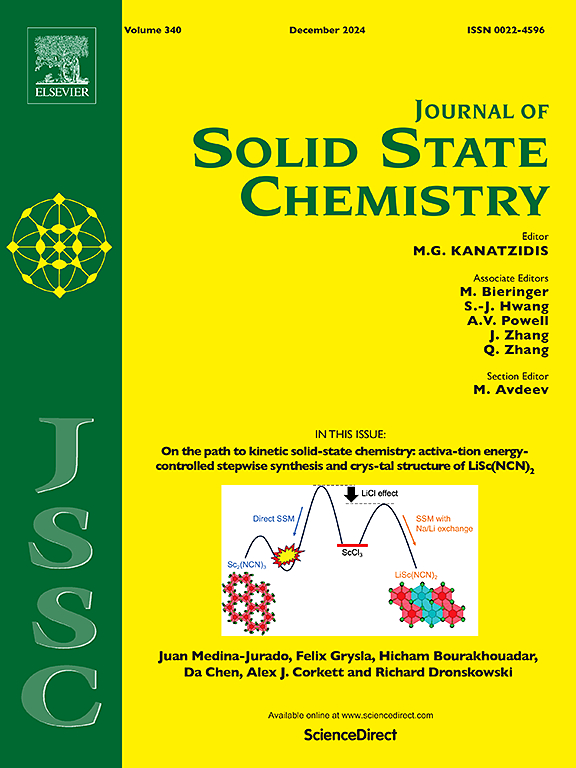Syntheses, crystal structures, and electronic structures of new barium fluoromolybdates
IF 3.5
3区 化学
Q2 CHEMISTRY, INORGANIC & NUCLEAR
引用次数: 0
Abstract
Four new barium fluoromolybdates, Ba2Mo6O19F2 (1), BaMoO3F2 (2), Ba2Mo2O5F6 (3), and Ba3Mo2O5F4(H2O)2·4IO3 (4) were synthesized under hydrothermal conditions, and their crystal structures were determined using single-crystal X-ray diffraction (SCXRD). By adjusting the amount of HF during synthesis, four distinct types of MoO6-xFx (X = 0 to 3) octahedra were identified: MoO6, MoO5F, MoO4F2, and MoO3F3, all exhibiting pronounced out-of-center distortions. Compound 1 features a three-dimensional (3D) framework composed of MoO6 and MoO5F octahedra, while compound 2 adopts a one-dimensional (1D) chain structure built from MoO5F and MoO3F3 octahedra. Compounds 3 and 4 are discrete dimers formed by corner-sharing two MoO3F3 octahedra in compound 3 and two MoO4F2 octahedra in compound 4. The assignment of Ba, Mo, I, O, and F in these compounds was validated using bond valence sum (BVS) calculations. Additionally, compound 4 was analyzed further using scanning electron microscopy with energy dispersive X-ray spectroscopy (SEM-EDX), infrared (IR) spectroscopy, thermogravimetric analysis (TGA) and ultraviolet–visible–near infrared spectroscopy (UV–Vis–NIR). Band structures and density of states were calculated for all four compounds to provide insight into their electronic structures.

新型氟钼酸钡的合成、晶体结构和电子结构
在水热条件下合成了Ba2Mo6O19F2(1)、BaMoO3F2(2)、Ba2Mo2O5F6(3)和Ba3Mo2O5F4(H2O)2·4IO3(4)四种新型氟钼酸钡,并利用单晶x射线衍射(SCXRD)对其晶体结构进行了表征。通过调整合成过程中HF的量,确定了四种不同类型的MoO6- xfx (X = 0 ~ 3)八面体:MoO6、MoO5F、MoO4F2和MoO3F3,它们都表现出明显的中心外畸变。化合物1是由MoO6和MoO5F八面体构成的三维(3D)框架,而化合物2是由MoO5F和MoO3F3八面体构成的一维(1D)链结构。化合物3和4是由化合物3的两个MoO3F3八面体和化合物4的两个MoO4F2八面体共用角而形成的离散二聚体。利用键价和(BVS)计算验证了这些化合物中Ba、Mo、I、O和F的配位。利用扫描电子显微镜(SEM-EDX)、红外光谱(IR)、热重分析(TGA)和紫外-可见-近红外光谱(UV-Vis-NIR)对化合物4进行了进一步分析。计算了所有四种化合物的能带结构和态密度,以深入了解它们的电子结构。
本文章由计算机程序翻译,如有差异,请以英文原文为准。
求助全文
约1分钟内获得全文
求助全文
来源期刊

Journal of Solid State Chemistry
化学-无机化学与核化学
CiteScore
6.00
自引率
9.10%
发文量
848
审稿时长
25 days
期刊介绍:
Covering major developments in the field of solid state chemistry and related areas such as ceramics and amorphous materials, the Journal of Solid State Chemistry features studies of chemical, structural, thermodynamic, electronic, magnetic, and optical properties and processes in solids.
 求助内容:
求助内容: 应助结果提醒方式:
应助结果提醒方式:


